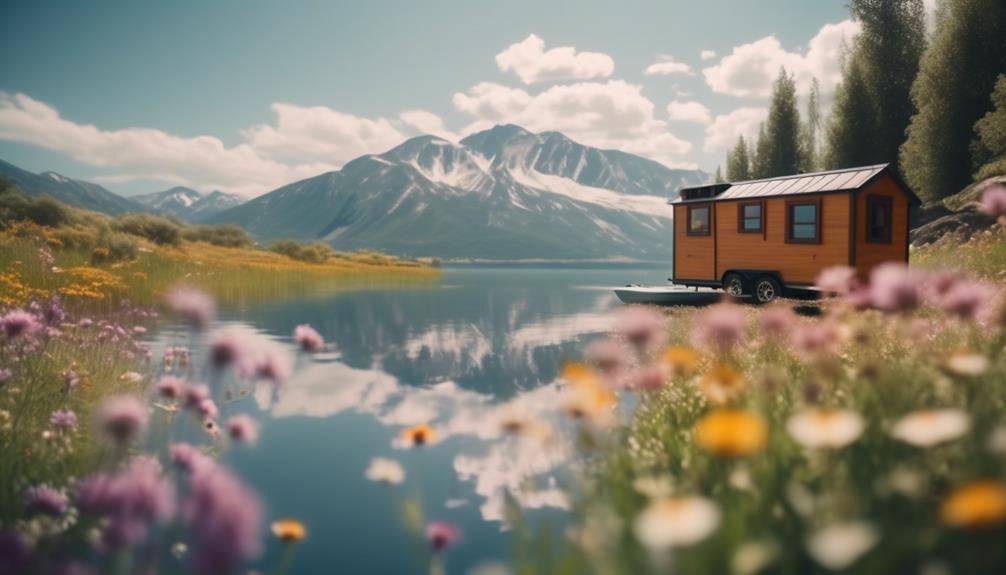Imagine waking up each morning in a space that's uniquely yours, not just in its quaint charm, but in its very location – the crux of the tiny home appeal.
You've already embraced the minimalist lifestyle, but the question remains: where should you plant your petite dwelling? From the bucolic serenity of a rural backdrop to the bustling heartbeat of urban life, each setting offers its own tapestry of experiences and challenges.
As you contemplate the patch of Earth where your tiny home will reside, factor in local zoning laws, the proximity to essential services, and the community ethos that resonates with your personal ideals.
In navigating the myriad of landscapes available to you, it's crucial to strike a balance between your longing for freedom and the practicalities of tiny home living. The journey to pinpoint the perfect location is laden with considerations that will influence not just your lifestyle, but the feasibility and legality of your tiny home.
Let's explore the contours of this decision, ensuring that your home's foundation is as solid as the life you're building within its walls.
Key Takeaways
- Familiarize yourself with local zoning laws and regulations to ensure compliance when choosing a location for your tiny home.
- Consider joining a tiny house community that adheres to local zoning laws and building codes, and offers shared facilities and a community-centric lifestyle.
- When considering a rural setting, balance the tranquility and potential cost savings with the limited services and potential hurdles such as restricted internet access and longer commutes.
- In urban areas, familiarize yourself with local zoning codes and seek neighborhoods that actively support urban living with tiny houses, aligning with municipal sustainability initiatives. Embrace an innovative mindset to navigate urban tiny house placement.
Exploring Zoning Laws and Regulations
Before setting your tiny home on a plot of land, delve into the local zoning laws to ensure you're in strict compliance with area-specific regulations. Zoning codes dictate where you can build or park a tiny house, which could be classified under accessory dwelling units or a local tiny house category.
It's vital to familiarize yourself with the intricacies of these codes, as they directly influence your ability to legally park and inhabit your tiny home.
To navigate this regulatory landscape, tap into resources like the Tiny House Expedition Resource Directory for state-specific guidance. Engage with your local zoning department for the most accurate and current information.
Complying with building codes from the get-go will streamline your journey in establishing a legal tiny house on your chosen site.
Considering Tiny House Communities
If you're seeking a community-centric lifestyle tailored to tiny living, consider joining a tiny house community. These communities offer a sustainable and innovative approach to tiny home living. They provide residents with the opportunity to park their tiny houses in designated areas that foster social interaction and mutual support.
Here are key considerations when choosing a tiny house community:
- Regulatory Compliance: Ensure that the community adheres to local zoning laws, building codes, and policy requirements for tiny homes.
- Community Amenities: Look for shared facilities that promote a collective lifestyle. Examples include laundry rooms, gardens, or event spaces.
- Affordability: Tiny house communities often provide affordable housing options. However, assess the dues and fees associated with the community to make sure they align with your budget.
As living continues to evolve, these home communities offer a progressive and collaborative alternative to traditional or RV parks.
Weighing the Pros and Cons of Rural Settings

When considering a rural setting for your tiny home, it's imperative to balance the tranquility and potential cost savings against the challenges of limited services and infrastructure.
Rural settings offer a serene environment where you can park your home amidst nature, often at a lower real estate cost compared to urban areas. The relaxed zoning laws may facilitate finding a place to establish your tiny house without the constraints typical of more densely populated areas.
However, be mindful of the regulatory landscape governing utility connections and the availability of essential services. While you may embrace a slower pace of living in a rural spot to park, anticipate potential hurdles such as restricted internet access and longer commutes for daily necessities.
Always investigate local policies thoroughly to ensure your tiny house community aligns with the innovative lifestyle you seek.
Urban Living With a Tiny Twist
Embracing Urban Living With a Tiny Twist allows you to enjoy the rich tapestry of city amenities while adhering to minimalist principles and local zoning regulations. You'll need to navigate the complexities of urban tiny house placement with an innovative mindset. Consider these key points:
- Zoning Laws: Familiarize yourself with the local zoning codes—some cities have a minimum square footage requirement that might affect where you can legally park your Tiny House.
- Community Integration: Seek out neighborhoods that actively support urban living with a tiny twist, fostering a community atmosphere that embraces tiny houses.
- Sustainability Efforts: Align with municipal sustainability initiatives that may offer specific areas where you can place to park your home, contributing to a forward-thinking, eco-conscious urban landscape.
Embracing the Nomadic Lifestyle

As you consider adopting a nomadic lifestyle with your tiny home on wheels, it's crucial to stay informed about the regulations and policies that govern such a mobile way of life. While you find a place to live tiny, understand that tiny living is not just a trend—it's a regulatory puzzle. To fly under the radar, you'll need to be detail-oriented and policy-aware.
| Aspect | Detail | Emotional Impact |
|---|---|---|
| Freedom | Unbound by static roots | Exhilaration |
| Sustainability | Lesser ecological footprint | Pride |
| Community | Online forums and meetups | Belonging |
| Connection | Proximity to nature | Serenity |
Embrace the nomadic lifestyle, but remember, living in a tiny house on wheels requires diligence in tracking changing laws to ensure you can continue to live in a tiny, innovative home without interruptions.
Frequently Asked Questions
Where Is the Best Place to Put a Tiny House?
You'll find the best spot for your tiny house by considering Rural Retreats, Urban Infill, or maybe a Backyard Oasis. Ensure it meets zoning laws for Lakeside Lots, Mountain Hideaways, or Coastal Escapes.
Where Are Most Tiny Homes Located?
You might think zoning challenges limit you, but most tiny homes find spots in rural retreats, urban infill, or as backyard oasis. Embrace community living, off-grid escapes, and vacation properties on mobile lots.
Where Can I Put a Tiny House in the Us?
You can park your tiny house in various US locations, considering zoning challenges, legal considerations, and mobile options. Explore backyard placements, rural settings, community living, off-grid locations, and urban possibilities carefully.
How Do I Find Space in My Tiny House?
To maximize your tiny house space, install vertical shelving and multifunctional furniture. Opt for hidden compartments, space-saving appliances, a lofted bed, wall-mounted desks, and foldable units for innovative, policy-compliant space management.
Conclusion
Finding the right spot for your tiny home is like piecing together a complex puzzle. You need to fit within the framework of local regulations, snugly aligning with zoning laws and community guidelines.
Ensure you're not just settling for any corner but are consciously selecting a space that ticks all the regulatory checkboxes. By staying informed and policy-savvy, your tiny abode will stand on solid ground, both literally and legally.

